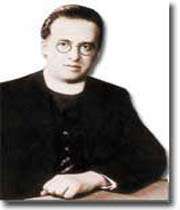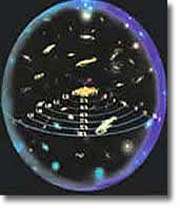
In the Quran, which was revealed fourteen centuries ago at a time when the science of astronomy was still primitive, the expansion of the universe was described in the following terms:
And it is We Who have constructed the heaven with might, and verily, it is We Who are steadily expanding it. (Quran, 51:47)
The word "heaven," as stated in the verse above, is used in various places in the Quran. It is referring to space and the wider universe. Here again, the word is used with this meaning, stating that the universe "expands." The Arabic word "moosiaaoona" in the term "inna lamoosiaaoona," translated into English as "it is We Who are steadily expanding it", comes from the verb "evsea," meaning "to expand." The prefix "la" emphasises the following name or title and adds a sense of "to a great extent." This expression therefore means "We expand the sky or the universe to a great extent." This is the very conclusion that science has reached today. 1

Georges Lemaitre
Until the dawn of the 20th century, the only view prevailing in the world of science was that "the universe has a constant nature and it has existed since infinite time." However, modern research, observations, and calculations carried out by means of modern technology have revealed that the universe in fact had a beginning and that it constantly "expands."
At the beginning of the 20th century, the Russian physicist Alexander Friedmann and the Belgian cosmologist Georges Lemaitre theoretically calculated that the universe is in constant motion and that it is expanding.

From the moment of the Big Bang, the universe has been constantly expanding at a great speed. Scientists compare the expanding universe to the surface of a balloon that is inflated.
This notion was confirmed by the use of observational data in 1929. While observing the sky with a telescope, Edwin Hubble, the American astronomer, discovered that the stars and galaxies were constantly moving away from each other. This discovery is regarded as one of the greatest in the history of astronomy. During these observations, Hubble established that the stars emit a light that turns redder according to their distance. That is because according to the known laws of physics, light heading towards a point of observation turns violet, and light moving away from that point assumes a more reddish hue.
The stars and galaxies were not only moving away from us, but also from each other. A universe where everything constantly moves away from everything else implied a constantly expanding universe. The observations carried out in the following years verified that the universe is constantly expanding.
In order to gain a clearer understanding of this, let us imagine the universe to be the surface of a balloon being inflated. In the same way that the more the balloon is inflated, the further away the points on its surface move from one another, celestial bodies also move away from one another as the universe expands. This was theoretically discovered by Albert Einstein, regarded as one of the greatest scientists of the 20th century. However, in order to avoid violating the "static universe model" that was generally accepted at that time, Einstein laid that discovery aside. He would later describe this as the greatest blunder of his life. 2
This fact was explained in the Quran in a time when telescopes and similar technological advancements were not even close to being invented. This is because the Quran is the Word of Allah: the Creator and Ruler of the entire universe.
source : tebyan













